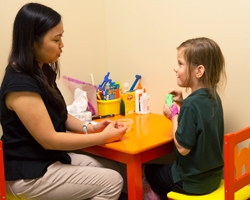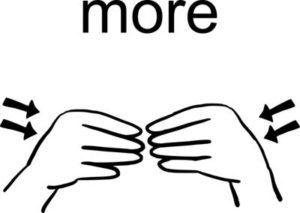Encouraging Effective Communication and Discouraging Negative Behavior
By Katy Moakley, CFY-SLP
Kids Place Pediatric Speech Therapist
When children are learning how to communicate, they learn that their actions influence your actions (cause and effect). This is the basis of communication. In order to get what they want, children will use the simplest, most effective option. If a child wants to be finished with a toy, he may push it away (sometimes off a table or surface) to convey that message to the parent. If this action is rewarded with the toy being removed by the parent, the child will continue to use pushing to communicate. Similarly, a child may forcefully grab a toy from a parent’s hands to indicate that he wants to play with that toy. If the child is then rewarded with the toy, the action is reinforced and grabbing behavior is very likely to continue.
How will my child learn alternative behaviors?
YOU can teach them, with help from your child’s therapy and/or education team. By using meaningful gestures, words, and signs, you can demonstrate the communication tools you want your child to use. If a child grabs/reaches for a toy, you can withhold that item (it’s best if it appears unintentional, as if you don’t understand what they’re asking for) and model either a meaningful gesture, word, or sign for that item. Encourage your child to imitate your model of communication. When your child imitates you or attempts to imitate you, reinforce that behavior with the desired item. Your child will make the connection that the grabbing behavior was not effective and the positive communication attempt was effective.
What if my child gets upset?
Children may react negatively at first if grabbing, for example, was previously effective and you start to require a communication attempt (sign or word) instead. You can help your child by assisting him with making a sign language gesture with their hands (a method called hand-over-hand assistance), or encouraging imitation of a verbal request. Your physical, occupational, and speech therapists will also encourage positive communication behavior, which provides valuable consistency.
What if my child is a delayed talker/communicator?
Reinforcing communication attempts/imitations is especially important for children who are delayed talkers/communicators. Since verbal communication may develop later for these children, it’s important to reinforce the basics of communication – that desired items/activities can be requested, played with, and completed using language and meaningful gestures (words or signs).
In a nutshell…
Use positive communication attempts like words, word approximations, and signs.
Then reinforce with the child receiving what he wants. This could mean beginning to play with a toy, being finished with a toy, receiving a desired item, etc.
DO reinforce:
- imitation of signs and sounds/words
- attempts to imitate, even if they are inaccurate
- completing a chosen activity from start to finish, and cleaning up an activity before moving on to the next
Try NOT to reinforce:
- crying, screaming, yelling to make requests
- grabbing, pushing, and pulling
- tantrums
Here are some example signs that you can begin to teach your child:












